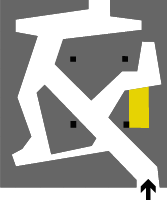Jan Tkocz 1886 - 1945 Edit
Born 29.8.1886 in Chwałowice
Died 28.2.1945 in Gusen
Biography
Jan Tkocz was born on 29 August 1886 in Chwałowice in Poland. He was the head of the heroic Tkocz family whose uncrushable resistance to German occupation during the Second World War is widely described in many Polish books and articles.
Jan, his wife and their eight children lived in a small house in Chwałowice. This house became the symbol of patriotism in Silesia. Right from the first days of the Second World War, this inconspicuous house was the central headquarters of conspiratorial activity. There were two underground, waterproof concrete shelters, a radio set and a duplicating machine under the house. Escapees from the Nazi camps were hidden in these shelters. The duplicating machine was used for printing the Zryw magazine (edited by Jan’s children to spread information and motivate people to fight) and for making copies of patriotic leaflets. The radio set was used to inform Polish people about the situation at the fronts. The Tkocz’s house was called ‘The fortress of the Polish character’ by the Germans. The house was blown up by the Nazis on 8 December 1944.
Jan took part in the Silesian Uprisings. He had been a member of the Polska Organizacja Wojskowa (Polish Military Organisation) in Upper Silesia during the First World War and was a member of the Związek Walki Zbrojnej (Union of Armed Struggle) during the Second.
Jan was arrested on 13 July 1944 at his workplace, a coal mine. The Nazis took him to Groß-Rosen and then to Mauthausen (20 September 1944), where he was murdered on 28 February 1945 at 7.10am. The cause of the death was given as poor circulation and general deterioration of the body. Jan’s prisoner number was 105183.
Jan, his wife and four of their children were murdered by the Nazis during World War II. The Tkocz family will never be forgotten though. In Silesia there is a street and a primary school named after them. The Tkocz family is always mentioned in any lecture, school assembly, radio broadcast or event about the activities of people in Silesia during the Second World War. There are also two monuments in Rybnik erected in honour of the Tkocz family and one in Tychy in honour of Jan’s son Ryszard.
Bożena Kołacz, freat granddaughter
References:
Mieczysław Brzost: Rybnicki Inspektorat Armii Krajowej [Rybnik Inspectorate of the Home Army] (Katowice, 1995).
Jerzy Klistała: Działacze rybnickiego ZWZ/AK w obozach koncentracyjnych [Rybnik ZWZ/AK activists in concentration camps], part.II (Bielsko-Biała 2003).
Jerzy Klistała: Martyrologium mieszkańców Ziemi Rybnickiej, Wodzisławia Śląskiego, Żor, Raciborza w latach 1939–1945 – Słownik biograficzny [Martyrologium of the inhabitants of Rybnik, Wodzisław Śląski, Żory, Racibórz in the years 1939–1945 – Biographical Dictionary] (Żory 2006).
Musiolik Longin: Śląscy Patroni Rybnickich Ulic [Silesian Patrons of Streets in Rybnik] (Rybnik 1994).
Innocenty Libura: Z dziejów domowych powiatu. Gawęda o ziemi rybnickiej [From the history of the county. Tales from Rybnik] (Opole 1984).
Jan Walczak: Rybnik. Zarys dziejów miasta od czasów najdawniejszych do 1980 roku [Rybnik. An outline of the history of the city from the earliest times to 1980] (Katowice 1986).
